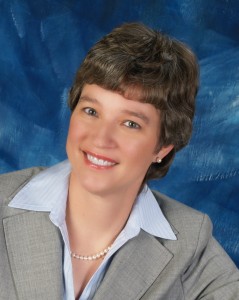Dawn Wooley, Ph.D., an associate professor of virology at Wright State University, has been selected to serve on the prestigious 21-member Recombinant DNA Advisory Committee (RAC) that advises the director of the National Institutes of Health (NIH).
Wooley was selected to serve on the RAC because of her expertise in recombinant DNA–particularly in viral vector technology–and her knowledge in biosafety.
“Our department is very proud of Dr. Wooley’s efforts,” said Tim Cope, Ph.D., chair of the Neuroscience, Cell Biology and Physiology Department. “Her selection to this national panel is highly significant recognition for Wright State University.”
The RAC, established in 1974, has become a critically important forum for open, public deliberation on the scientific, ethical and legal issues raised by recombinant DNA and its research applications. It is made up of experts from a wide range of scientific and medical fields and also includes ethicists and members of patient and other lay communities.
Compliance with the NIH guidelines on recombinant DNA is mandatory for institutions receiving NIH funds for such research, and the guidelines have become a universal standard for safe scientific practice, followed voluntarily by many institutions and companies.
“It’s a huge honor to be on this committee,” said Wooley, who works in the Department of Neuroscience, Cell Biology, and Physiology at Wright State’s Boonshoft School of Medicine. “This is a distinction for Wright State.”
Wooley will attend her first RAC meeting later this week in Rockville, MD. The gathering will include a workshop on gene transfer and rare diseases.
The RAC makes recommendations on research involving the use of recombinant DNA—including novel and possibly risky research—as well as developments in technology. A major responsibility is to review human gene transfer research. Gene therapy is used to fight disease by delivering immunogenic vaccines and corrective genes into patients.
Recombinant DNA is created when genetic material from multiple sources is brought together, resulting in DNA sequences that would not otherwise be found in nature. In some cases, these molecules are delivered by microorganisms, such as viruses. Recombinant DNA is used widely in biotechnology, medicine, and research and can be found in products at pharmacies, doctor’s offices, supermarkets, and farms. Examples include human insulin, human growth hormone, hepatitis B vaccine, and insect-resistant crops.
Although recombinant DNA has become widely accepted, concerns remain when the technology leaves the laboratory and is introduced into a patient, the environment, or the food chain.
“This type of research must be fully reviewed if you’re going to start putting this into people,” said Wooley. “For example, what if the new treatment harms the patient, spreads to a family member, becomes contagious, or is inherited by future generations?”
The RAC considers these possibilities and helps prevent them from occurring by making recommendations on the safe conduct of such research.
At Wright State, Wooley investigates HIV/AIDS, focusing on how the AIDS virus mutates and causes disease. Wooley also conducts research on the safety of engineered viruses, known as viral vectors, and studies the antiviral effects of nanomaterials. Together with Katherine Excoffon, Ph.D., from the Department of Biological Sciences, Wooley is currently working on a gene therapy against HIV infection.
Wooley earned her bachelor’s degree in microbiology at the Pennsylvania State University and her Ph.D. in virology at Harvard, where she studied the AIDS virus. Wooley later performed post-doctoral training at the University of Wisconsin Medical School with the late Nobel Laureate and geneticist Howard Temin. In 2005, Wooley became certified as a Specialist Microbiologist in Biological Safety from the National Registry of Certified Microbiologists and later became certified as a Biosafety Professional through the American Biological Safety Association, a credential held by only 138 people worldwide.


 Wright State University Foundation awards Students First Fund grants
Wright State University Foundation awards Students First Fund grants  Cosmic collection
Cosmic collection  Wright State revives student-faculty collaborative writing journal
Wright State revives student-faculty collaborative writing journal  Fulfilling dreams
Fulfilling dreams  Wright State alumna Nicole Scherzinger wins top British theatre award as star of ‘Sunset Boulevard’
Wright State alumna Nicole Scherzinger wins top British theatre award as star of ‘Sunset Boulevard’ 